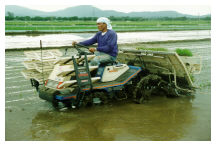|
|
|
Planting the rice |
|
||||||||||
|
|
|
|
|
||||||||||
|
|
|
Planting technique: Transplanting |
|
||||||||||
|
|
|
|
|
||||||||||
|
|
|
Describe the process of transplanting |
|
||||||||||
Transplanting: less seed but more labor |
|
What is transplanting?
The other way of establishment is not by sowing seeds but by transplanting seedlings that are grown in nurseries first. Transplanting of rice seedlings into puddled fields is widely practiced in Asia, primarily to better control weeds. Transplanting requires less seed but much more labor, and the crop takes longer to mature because of the transplanting shock.
|
|
||||||||||
Different varieties need a different moment of transplanting |
|
How old do the seedlings need to be?
Before being transplanted, seedlings are grown for different lengths of time in the nursery:
|
|
||||||||||
|
|
|
How to transplant manually (by hand)?
On loamy and clayey soils, transplanting is delayed for 1 to 3 days after the final working because the soil is too weak to support the seedling. In some sandy soils, transplanting is undertaken within hours of final harrowing else the soil becomes too hard to manually implant the seedling. In areas where there has been insufficient rain and the soil is hard, transplanting may also be done in non-flooded soils by using a stick to make a hole to implant the seedling.
Manual transplanting of seedlings is very labor intensive. Depending on the soil, you might need 30 to 40 people a day to plant 1 hectare of rice!
Seedlings should be planted at 1.5 centimeters of depth.
|
|
||||||||||
|
|
|
||||||||||||
|
|
|
|
|||||||||||
|
|
|
Planting in straight rows will make it easier to weed or apply fertilizers, herbicides, or insecticides. More importantly, you will get the best plant spacing.
Plant spacing Plant spacing is an important factor in transplanting rice. Proper spacing can increase the yield by 25 to 40% over improper spacing. You will also save money on inputs, labor, and materials.
Click here to learn how far apart to plant the seedlings! |
|
||||||||||
|
|
|
How to transplant mechanically (by machine)?
While the majority of rice fields in Asia are manually transplanted, a number of different transplanters are available. Machines with varying levels of complexity are manufactured in China, Japan, South-Korea and Taiwan. Machines range in size from two-row, walk-behind models to eight-row, ride-on models.
Most mechanical transplanters place seedlings in rows 30 cm apart with in-row spacing determined by forward speed.
Land must be well prepared for machine transplanting. The soil needs to be level and have sufficient bearing strength to carry the machine and support the planted seedlings. Fields may need to be drained one or two days longer than they are for hand transplanting. |
|
||||||||||
|
|
|
||||||||||||
Go online for more information |
|
For more information on Crop Establishment, please visit: http://www.knowledgebank.irri.org/PlantEstablish/WebHelp/default.htm |
|
||||||||||
Next lesson |
|
If we use transplanting as the method to plant then we should make sure we have a proper nursery to grow the seedlings. Let's have a look at some nursery systems. |
|
||||||||||











